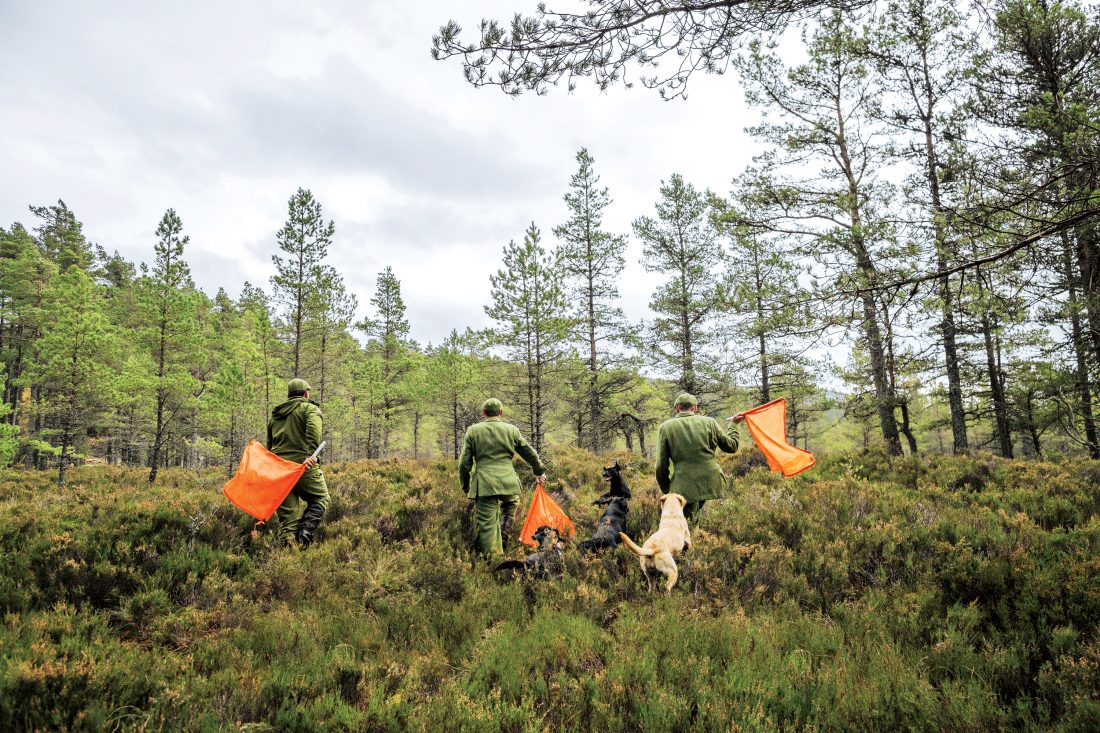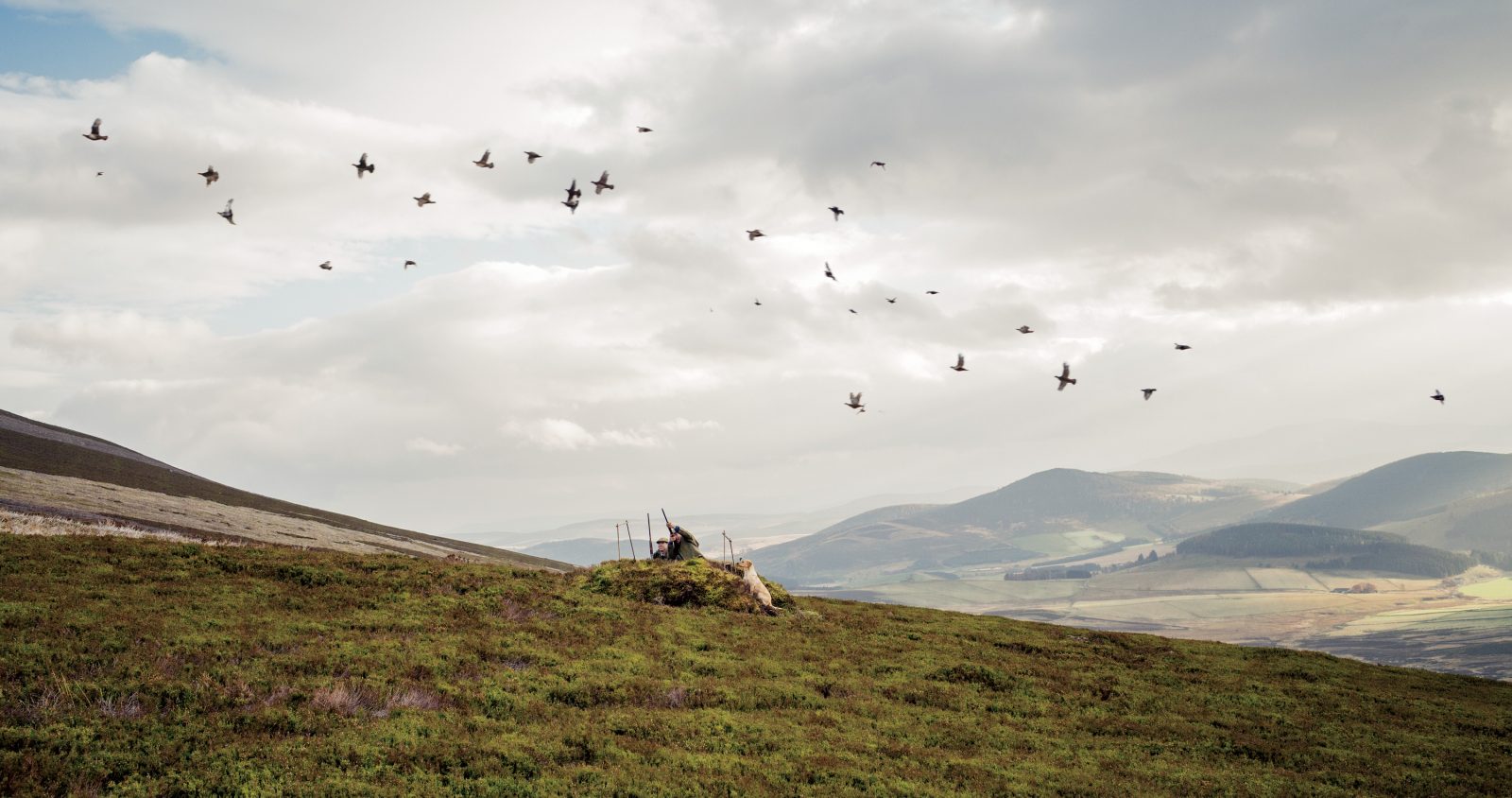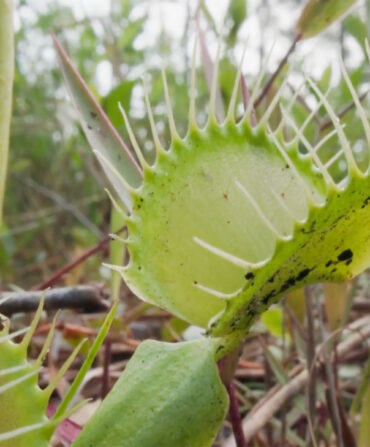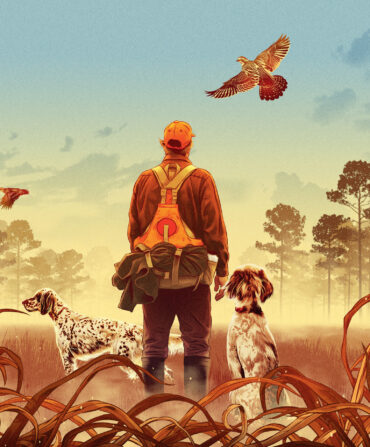Good Dogs
Sporting South: The Driven Way

Andy Anderson
On a classic British driven shoot, one is shooting, not hunting, according to correct nomenclature. But this is no dove shoot. Pushed off a high hillside hundreds of yards in front of the guns, curling for his home wood, perhaps with a tailwind that makes him fly even faster, a tall driven pheasant is one of the most testing targets one will ever encounter. Consider this: If you are averaging one bird for three cartridges, you are regarded as a good shot, and if you are averaging fewer than two cartridges for one bird on difficult shoots and drives, you are considered outstanding.
A British driven shoot for pheasant or partridge plays out today much the same as it did in Edwardian times. A team of beaters around twenty strong push birds out of woods (traditional) or more commonly today out of game fields toward the guns (shooters). Pickers-up methodically work their retrievers and spaniels behind, concentrating on runners during the drive. A team in Britain is typically eight guns, and on a driven shoot, one tries to avoid shooting one’s neighbor’s bird (not to mention one’s neighbor).
What makes for a good shoot? Having been on more than a thousand driven days, for me it is a combination of challenging birds and a shoot that does not have a commercial feel to it. I don’t want to feel like I’m being processed, and I don’t want the lunch to taste as if it’s been either. Another consideration is ambience. To shoot Britain today is in many ways to go back to a bygone era, and to be able to see spectacular country and estates. Many great shoots are associated with rather magnificent houses—Drumlanrig Castle in Scotland, for example, and Highclere outside London, now best known as the backdrop for Downton Abbey. And beyond all this is the sport. While some shoots generally prefer teams, others can accommodate individual guns. But most of these fabulous shoots are booked out almost a year in advance, so if you want to experience driven shooting in the land where it has reached its pinnacle, the time to start planning is now.

Andy Anderson
Here They Come
Red grouse fly over the guns on a Scottish moor.
Scotland
The Lay of the Land:
From mountains to moorland to peat bogs, the variety of terrain in Scotland is unique in the British Isles, and it has a wildness to it that is unmatched in most of Britain. Another joy of shooting in Scotland is that castles, lodges, and manor houses can often be rented to accommodate the team.
The Shoot:
Managed by Wilson Young, Eskdale Shooting Services has been running shoots for more than thirty-five years and is highly regarded for both its roster of estates and the quality of shooting that it provides. In fact, days often consist of a couple of drives on each of a number of estates. Two of the most famous are Thirlestane Castle and Bowmont Valley [1], and for good reason. Thirlestane is both a beautiful property and a serious shoot, set on ten thousand acres with thirty-one pheasant and twenty-five partridge drives. The signature drive is the Face, where pheasant in unbelievable quantity are driven out of steep woods toward the guns, with others back-gunning below. Bowmont Valley is primarily designed around deep valleys on the edge of a grouse moor. The shoots are professionally run but with the sort of thoughtfulness rarely found in commercial shoots—good food, and even better wine. There are a number of hotels in the area, and for those bringing a group, the summer residence of the Duke and Duchess of Northumberland and the beautiful newly completed Lylestane House offer private accommodations.—gameshootingscotland.com
Alternate:
Set on ninety thousand acres, Drumlanrig Castle [2] is one of a number of estates owned by the Duke of Buccleuch. The castle itself dates back to the 1600s, and it offers both partridge and pheasant shoots that rank among Britain’s finest. Accommodations are available at the castle or at the lovely Buccleuch and Queensberry Arms Hotel, a few miles away.—roxtons.com
Northern England
The Lay of the Land:
The North of England was famous for its grand Victorian and Edwardian house parties. The topography varies greatly, but many shoots produce stunningly sporting birds.
The Shoot:
Ripley Castle [3] is the aegis under which several estates have been brought together, providing tremendous variety in both terrain and skill level. Pheasant and partridge vary from medium to very tall depending on the drives chosen, and this is one of the few places in Yorkshire where one can join the line individually rather than coming as part of a team. Some of the land originally belonged to Lord Mountgarret, who once famously shot at a hot-air balloon that drifted over during one of his drives, as he felt it was…interfering.—ripleycastleshoot.com
Alternate:
Set in the Yorkshire Dales, Swinton [4] is a large, historic estate and shoot, run by Mark Cunliffe-Lister, the current Lord Masham, whose family acquired the 20,000-acre property in the 1880s. Guns can stay in the award-winning luxury castle hotel, and birds vary in height from good sporting to excellent. Apocryphal or not, the story goes that the royal family, after inspecting Swinton, decided that the pheasant were a bit too high. Swinton also boasts a productive grouse moor—not surprising, as Yorkshire is the epicenter for driven grouse.—theswintonestate.com
Wales
The Lay of the Land:
Wales has a combination of rolling hills with valley bottoms, but also imposing mountains from which birds are driven toward the guns. Waterfalls and rivers in spate are typical features of the rugged, dramatic landscapes.
The Shoot:
The Bettws Hall company manages a number of shoots in Wales and England, the most demanding of which is Brigands [5]. Located on the southern edge of Snowdonia National Park, it covers fourteen thousand acres and more than thirty-five drives, and the scenery alone is worth the trip. Indeed, as one approaches the shoot, the hills give way, sometimes as one turns a corner, to steep mountainsides that portend tall birds. The signature drive, Hellfire, lives up to its name. A huge gorse bank runs up a ridge three hundred to four hundred yards in front of the guns. Hidden behind the gorse is a game crop from which the birds are driven. From that distance they hardly seem to be moving. But before you know it, these tall and fast birds are over the pegs and in a heartbeat they are gone. A true high-bird specialist, almost like a chess player, can plan out birds to be taken in order. Guests stay at Brigands Inn, which is located on the estate and run very much like a private house.—www.bettwshall.com
Alternate:
The stunning Vaynor Park [6] dates back to the mid-fifteenth century. The principal house sits in approximately 5,500 acres of beautiful countryside, boasting perhaps the best view of the Severn Valley from its terrace. Birds are driven from a mixture of game crops as well as mature woodlands with deep valleys that add diversity to the drives, providing sport for varying levels of ability.—www.bettwshall.com
Near London
The Lay of the Land:
Surprisingly, there are a number of shoots within an hour and a bit from London. One can spend the night in the city, get off to an early start, and have pheasant over one’s peg about the same time the rest of us are responding to the first e-mails of the day. While some come with grand homes, the relatively flat terrain does not always lend itself to showing challenging birds. But there are some notable exceptions.
The Shoot:
Situated in the heart of the beautiful and unspoiled South Downs National Park in West Sussex but only ninety minutes by road from Central London (less if my wife is driving), Cocking [7] is without a doubt the best shoot close to the city. Purely a pheasant shoot, it has deep, heavily wooded combes that provide excellent high pheasant. At its famous Chalk Pit drive, a road goes up a near-vertical incline, and guns are placed on three levels. The birds come out and have to climb to clear the line of trees near the precipice. For the guns on the left or the right side of the line, at all levels, birds are presented both as traditional directly overhead incoming shots and as crossers, which can be amazingly deceptive.—e-mail: theresa@pson.co.uk; phone: 011-44-179-886-1655
Alternate:
If you’re a fan of Downton Abbey, you’ll probably recognize Highclere Castle [8], where it’s filmed. The house is exceptional and designed by the architect Sir Charles Barry, who also designed the Houses of Parliament. The partridge shoot is traditional birds, flown over hedges. The pheasant shoot is also good, especially if one gets the drives from Siddown Hill. Shoot bookings start in mid-September with partridge, go on to mixed days in October, and become more pheasant-oriented from November onward.—highclerecastle.co.uk
The West Country
The Lay of the Land:
The epicenter of most of the great shoots of the West Country is Exmoor, the former and ancient royal hunting forest. The hilly terrain and deep valleys offer ideal topography for showing challenging pheasant and partridge, and it is here where the fashion, no longer a fad, for extreme tall pheasant became the norm. The West Country is a relatively easy drive from London, and there is also excellent train service, plus Bristol and Exeter airports, in the region.
The Shoot:
Lillycombe Estate [9], in the heart of Exmoor, is owned by the Earl and Countess of Lytton. Known mostly to cognoscenti, this is a great shoot—mixed pheasant and partridge, with stunning views over the sea to Wales. Early partridge in September are superb, and it moves primarily to pheasant as the season progresses. They are fortunate to have seven valleys on their estate, allowing great flexibility in choice of drives, based on weather conditions. The twenty-nine partridge and pheasant drives are generally tall, but there are drives to accommodate varying levels of shooters. The aim is top-quality shooting in an atmosphere of a private house party.—e-mail: uschilytton@btconnect.com; phone: 011-44-164-386-2534
Alternate:
One of the best shoots for tall pheasant in the West Country can be found at Haddeo [10], with some partridge as well. Angus Barnes, who owns the shooting rights and serves as the overall manager, is a gentleman of the first order, and the estate’s St. Paul’s drive is as good as one will find in Britain when it works. But it’s not for the fainthearted or the inexperienced tall bird shot.—loyton.com/sporting







